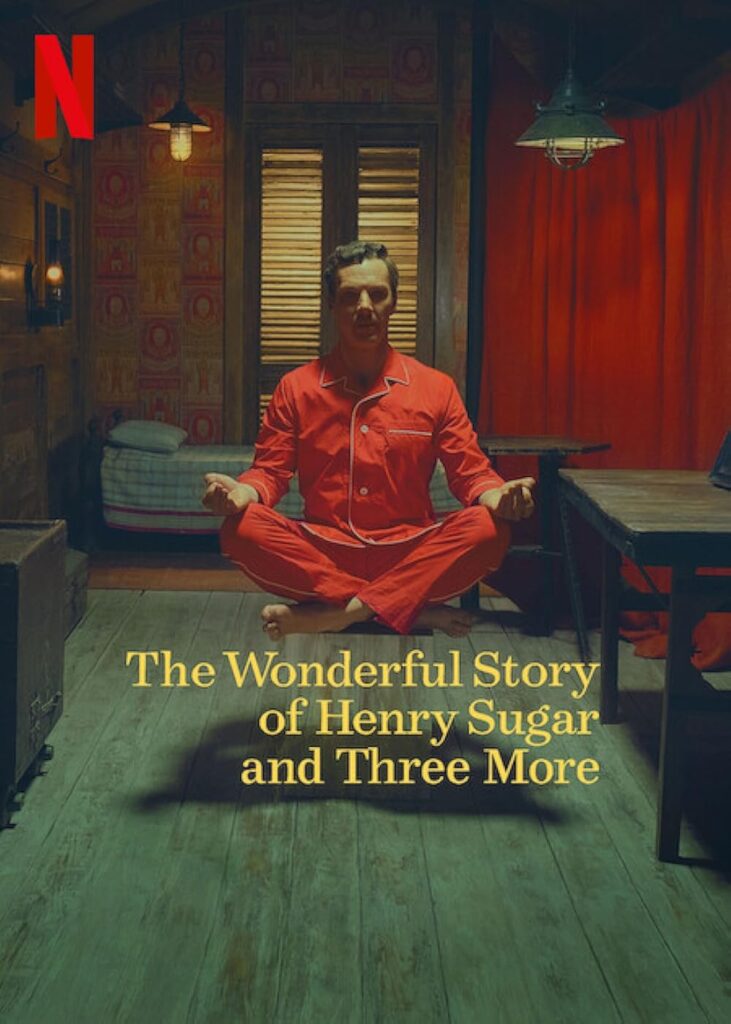The Wonderful Story of Henry Sugar and Three More Review

In 2023, Wes Anderson produced his second movie magic trick of the year (the first being “Asteroid City,” which was sublime) with a shaggy dog story that doesn’t have a hair out of place. The author is Roald Dahl, whose “The Fantastic Mr. Fox” served as Anderson’s initial foray into stop-motion animation. It was kind of a kid’s book, but not really Anderson respected its adult stresses and the slightly sinister undercurrent beneath its already sardonic ironies.
This is Anderson’s first Netflix movie, and it’s the first one he said he made under protest, sort of. He wanted to make it for a while, during which time Dahl’s estate cut what must have been a very nice deal with the streamer. What Anderson has given Netflix is an almost-40-minute precision-tooled narrative mostly in the boxy Academy ratio, although at key points, the frame itself bounces around in the wider frame overall.
It isn’t animated the actors are live-action and familiar and reliable: Ralph Fiennes plays a version of Dahl; the film opens in an Andersonian re-creation of the writer’s real-life “writing hut,” where Fiennes tells what purports to be a true story after mumbling about what it takes to get him started on one.
Dahl’s actual story could theoretically be made into a very expensive multi-location movie it takes place all over the world. But Anderson keeps it contained to meticulous sets (of course they’re meticulous) that here reminded me of Karel Zeman titles like “Journey to the Beginning of Time” or “The Stolen Airship,” those fantastic Czech films that put live-action actors into animated backgrounds. All actors address camera directly; they serve as narrators and characters; they speak quickly but not fast and with little overt inflection but quite a bit of subtle craft.
The words are almost all Dahl’s, but Anderson has condensed the actual short story, which is fanciful but hardly child-aimed (it’s not not child-unfriendly either). He understands he can’t top the dry wit of Dahl’s verbiage, so he doesn’t try. Describing the mega-rich title character, Dahl writes: “Men like Henry Sugar are to be found drifting like seaweed all over the world. They can be seen especially in London, New York, Paris, Nassau, Montego Bay, Cannes and San Tropez. They are not particularly bad men but they are not good men either. They are of no particular importance; they’re simply part of the decoration.”
The story is a meta-narrative (unless you believe that it’s true because how could Roald Dahl lie?) that takes off when bored Henry (Benedict Cumberbatch perfect) goes to the drastic extreme of taking a book off his rich friend’s library shelf. The slimmest volume he sees, of course. It turns out to be a sort of dissertation about a man who can see without his eyes. The man in question is played by Ben Kingsley; doctors who confirm his power are Dev Patel and Richard Ayoade. What catches Henry’s attention is this man’s ability to see through downturned playing cards. Henry has always been a gambler himself but not a particularly skilled one; he teaches himself how to see without eyes using a study method originated by a cranky yogi and absenting himself from society for several years because devotion/obsession
In the year 1963, a film named “X: The Man with X-Ray Eyes” directed by Roger Corman introduced the concept of a power that allows you to cheat at cards. In this movie, the power is achieved through chemical means and eventually becomes boring when one sees too much like what happens to Ray Milland’s character in the end of space which can really get depressing if you think about it given that this same idea is dealt with in Oppenheimer also.
This is not what happened with Henry though so there are some differences between them both; but if you don’t know about any of Dahl’s stories yet then be prepared for something less harsh than usual coming from him. It was touching and beautiful seeing an enlightenment fable told through miniature houses created by Anderson here he doesn’t try too hard to be strange but rather finds his center beautifully while telling us about it all here in “Henry Sugar”.
Watch The Wonderful Story of Henry Sugar and Three More For Free On Gomovies.
.jpg?w=1024&resize=1024,1024&ssl=1)
.jpg?w=1024&resize=1024,1024&ssl=1)
.jpg?w=1024&resize=1024,1024&ssl=1)
.jpg?w=1024&resize=1024,1024&ssl=1)
.webp?w=1024&resize=1024,1024&ssl=1)
.jpg?w=1024&resize=1024,1024&ssl=1)
.jpg?w=1024&resize=1024,1024&ssl=1)
.jpg?w=1024&resize=1024,1024&ssl=1)